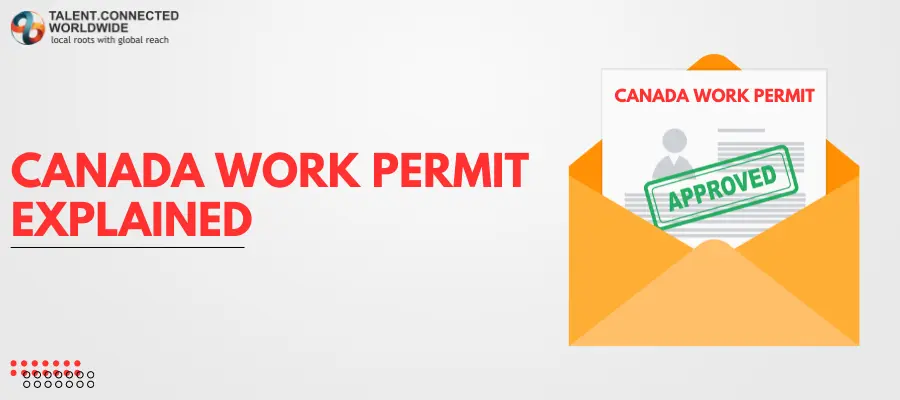
A Canada work permit is a written and authorized permission that allows eligible international workers to work in the country. You can only work in Canada if you have a work permit. It is issued by Employment and Social Development Canada (ESDC) and is based on a positive LMIA or a job offer from an LMIA-exempt employer.
It is recommend to gain valuable Canadian work experience so you can easily immigrate to Canada and obtain permanent residency.
This article includes:
- Types of Canada Work Permit
- Who can Apply?
- How to Apply?
- Letter of Introduction
- Getting the Work Permit
- Immigration pathways that need a Work Permit
- Get your Work Permit faster
Types of Canada Work Permit
There are two types of work permits in Canada:
1. Employer Specific Work Permit
An Employer Specific Work Permit (ESWP) allows foreign skilled workers to work in Canada but only for a specific employer. The work permit restricts the employee to get employed in Canada according to the conditions mentioned in the permit. These conditions are:
- The name of the employer you can work for.
- The duration for which you can work.
- The location where you can work.
2. Open Work Permit
With an Open Work Permit, you are allowed to work for any valid employer. An employer is valid if they are not on the list of non-compliant employers. An employer who offers services like erotic dances or massages is also deemed ineligible.
You will require an Open Work permit if:
- You are a Ukrainian National or a Temporary Resident permit holder
- You are in Canada and have been sponsored by a spouse
- You have applied for PR on humanitarian ground
- You are outside Quebec but have acquired a Certificat de sélection du Québec (CSQ)
Who Can Apply for a Canada Work Permit?
You can apply for a Canada work permit if you meet any of the following circumstances:
- If you have applied for Canada PR from outside Canada: In this case you will be required to apply for the Employer-Specific Work permit.
- If you have not applied for Canada PR and are outside Canada: In most cases you will need to apply for an Employer-specific Work permit (ESWP).
- If you have applied for Permanent Resident and are inside Canada: In this case, you will be eligible for a Bridging Open Work permit (BOWP).
- If you have not applied for Canada PR and are still in Canada: In this case, you will need to extend your existing Canada Work permit. You can apply for a Canadian work permit from within the country if:
- You already have a valid study permit or work permit
- Your spouse or legal partner has a valid study or work permit
- You qualify for a post-graduation work permit and have a valid study permit too
- Your parent or legal partner possesses a valid temporary resident permit which is still valid for 6 months or more
- You’re awaiting a decision on a permanent residency application through the in-Canada spousal class or the temporary resident permit holder class
- You have claimed refugee protection
- You are allowed to work without a Canada work permit but need one for a specific job
How to Apply for a Canada Work Permit?
Following these steps according to the phases to apply for a work permit in Canada.
Step 1: Decide Where to Apply From
Step 2: Application for work permit
Step 3: Applying online or offline
Step 4: Country selection
Step 5: Fill out the application form
Step 6: Provide necessary information
Step 7: Pay application fee
Step 8: Completion check
Step 9: Review for decision
Step 10: Approval
STEP 1: Decide Where to Apply From
The first step towards applying for a Canada work permit is to determine whether you will apply from:
- Outside Canada,
- Inside Canada, or
- At the Port of Entry
STEP 2: Application for work permit
Get the application for the work permit that is appropriate according to your circumstances. For instance, if you are outside Canada who needs a visitor visa, you will need an Employer Specific Work Permit (ESWP).
STEP 3: Applying online or offline
Determine if you are applying online or offline. You can only apply for a Canada work permit offline if you suffer from some disability that prevents you from applying online or are applying under seasonal agricultural worker programs.
You will need to create an account with IRCC to initiate the work permit application.
STEP 4: Country selection
Select the country you are applying from. For example, if you are applying from India, pick India.
STEP 5: Fill out the application form
Fill out the application and submit the following forms:
- Application for Work Permit made outside of Canada
- Document checklist
- Family information
STEP 6: Provide necessary information
Provide all the information and complete your Canada work permit application. You will be asked for the following information:
- Personal Information- this includes:
- Your full legal name as it appears on your passport and legal documents
- Any nicknames
- Gender
- Date and place of Birth
- Country of citizenship
- Country you are currently residing in
- Marital status
- Native language and language of communication
- Information about your passports
- Information about your work in Canada such as:
- Type of work permit you are applying for
- About LMIA and the 7-digit LMIA number
- Your place of work
- Duration of work
- About Education
- Your Work history
- Background information
STEP 7: Pay application fee
Pay the application fee and submit it to the IRCC. Canada work permit costs $155 CAD.
After applying for the Work Permit
STEP 8: Completion check
Once you submit your application for a Canadian work permit, it will be assessed by the IRCC for completion. The Immigration, Refugees and Citizenship Canada checks if the documents you have uploaded and submitted are complete.
STEP 9: Review for decision
Your work permit will be assessed for accuracy and authenticity. This is the stage where IRCC will either approve or reject your application.
STEP 10: Approval
Once the IRCC approves your Canada work permit application, you will receive a letter of introduction confirming the approval of your work permit.
Getting Canada Letter of Introduction
After IRCC accepts your work permit application, you will receive a Letter of Introduction. Canada Letter of Introduction does not guarantee your entry into the country. An officer at the Port of Entry (POE) will verify your eligibility and decide the duration of your permit. This will be the time you will receive your work permit. You must remember that the Port of Entry letter, also known as the Letter of Introduction is not a work permit.
Getting your Work Permit
Once you land in Canada you must have:
- A valid passport
- Visitor visa (if you are from India, you will require a visitor visa)
- Any travel document
- Letter of Introduction
- Copy of a positive LMIA
- CSQ or Certificat de sélection du Québec (if applicable)
Once the IRCC officer assesses all your documents and is convinced of your eligibility, your Canada work permit will be printed and issued to you. Thus, you will receive your work permit at the Port of Entry (POE).
Immigration Programs That Require a Work Permit
You must apply for a work permit as soon as you get a job offer and a positive LMIA from a valid Canadian employer. All immigration programs that require a job offer automatically require a work permit.
1. Express Entry
If you immigrate to Canada through the Express Entry system, you might be required to apply for a Bridging Open Work Permit (BOWP).
2. Provincial Nominee Programs
Canadian provinces and territories offer various pathways for skilled workers, students, and entrepreneurs to get provincial nominations and settle as permanent residents. All the PNP pathways that mandate a job offer as an eligibility requirement need a work permit. For such pathways, you will need an Employer Specific Work Permit (ESWP).
3. Atlantic Immigration Program (AIP)
You will need to have a two-year Employer Specific Work Permit (ESWP) if you want to apply for Canada PR through the Atlantic Immigration Program.
4. Rural and Northern Immigration Pilot (RNIP)
Canada Immigration through the RNIP pathway requires a one-year employer-specific work permit. In case you are accompanied by your spouse or legal partner, they can apply for an open work permit.
5. Québec-Selected Skilled Workers (QSW)
If you are living outside Quebec and get a Quebec Selection Certificate (CSQ), you will need an Open Work Permit. If you are already in Quebec with a CSQ and have applied for Canada PR through the Quebec Selected Skilled Workers, you might apply for a bridging open work permit.
6. Agri-Food Pilot
Applying for Canada PR through the Agri-Food Pilot program requires a bridging open work permit.
Note: These are only some of the immigration pathways that would require a work permit. Depending upon your profile, a permit may or may not be required. Ensure that you consult with your immigration consultant about all the requirements.
Canada Work Permit Processing Time & Fee
The Canadian work permit processing time and application processing fee are presented below.
| Type of Work Permit | Fee |
|---|---|
| Employer-Specific Work Permit (ESWP) – Single Applicant – A Group of 3 | CAN$155 CAN$465 |
| Open Work Permit | CAN$100 |
| Work Permit Applied From | Processing Time |
|---|---|
| India | 19 weeks |
| Canada | 158 Days |
Getting your work permit faster
Being employed in Canada offers a high-quality and balanced lifestyle. However, getting a job in the country and applying for a work permit can become a complex and intimidating task. Talent Connected Worldwide is a CICC-authorized award-winning immigration consultancy that offers premium Canada immigration and work permit services. From helping in deciding the type of work permit you are eligible for to getting your documents ready, we make the process extremely simple and fast. With us, your work permit is bound to get processed with minimal chances of rejection.
Thinking of safe and successful Canada immigration? Think Talent Connected Worldwide.
Don’t waste your time, contact us today!



